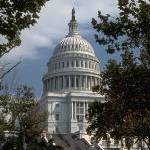
What’s more, this $19.3 billion increase was on top of a $20.4 billion increase in November. This marked the largest two month increase in consumer spending in over a decade. According to the Fed report, non-revolving debt, like auto and student loans, made up $16.6 billion of the debt increase and revolving debt, like credit cards, added $2.76 billion.
We don’t know what to make of consumer enthusiasm to pile on debt at prerecession rates. Have they once again lost their collective minds?
“Not yet, says Alan Levenson, chief economist at mutual fund giant T. Rowe Price in Baltimore.
“He pointed out that December’s total revolving credit of $801 billion was still far less than the peak of $972 billion in August 2008.
“Looking at another gauge, he said, overall consumer credit of $2.5 trillion was now 21.5 percent of after-tax income — near the low of the late 1990s.
“‘We’re still way off the cyclical peak,’ he said.”
Faith In Numbers
Maybe so. But despite officially being in recovery since June of 2009, the economy seems weaker than a watered down Budweiser beer. Will consumers finally rescue the economy?
The answer, of course, depends on how much faith you put in numbers. A government economist may point to the fact that consumer spending accounts for 70 percent of the economy. Following this reasoning, they may conclude that an increase in consumer credit is good for the economy and that it’ll lead to a rise in gross domestic product.
Here at the Economic Prism we care less about the number that’s reported and more about what that number represents. Economic growth that’s propelled by a rise in consumer credit is generally not something we get excited about. In our opinion, an increase in GDP that’s fueled by an increase in debt is not a measurement of economic growth; rather, it’s a measurement of the rate the economy’s going broke.
Regardless, enticing consumers to spend money on credit has been the goal of monetary policy since the 2007 recession began. When the federal funds rate was first pushed toward zero percent in late 2008, policy wonks all knew an economic boom was just around the corner. Yet with the exception of stock prices…the boom never came.
Following the 2008 credit crisis, the banks resisted loaning out more of the Fed’s cheap credit like a diabetic resists a Twinkie. The extreme fear and increase in lending standards following the housing market blow up caused banks to hold cash. Rather than flowing into the economy, the new money sat on bank balance sheets or was used to buy government debt.
What this means is Fed monetary policy did not have the desired stimulative effect on the economy. But that may now be changing…
False Booms
Last week, as noted above, the Federal Reserve reported the largest two month increase in consumer debt in over a decade. What this means is credit is now flowing into the economy again for the first time in since mid-2008 – or earlier.
But don’t be fooled by the boom that’s developing. It’s not a real boom fueled by savings and capital investment. It’s a false boom fueled by cheap credit induced consumption. The sooner the false boom ends the better for everyone, except President Obama.
The success of President Obama’s reelection bid is dependent on the strength and duration of the false boom. In Obama’s favor, consumers have rediscovered their enthusiasm for buying things they don’t need with money they don’t have. On top of that, the bond market continues to allow the government to borrow money from the future and spend it today for practically free.
Yesterday morning, on the Annandale campus of Northern Virginia Community College, Obama unveiled his 2013 spending plan. We’d hoped the plan would include a balanced budget. Unfortunately, even with all the insulting tax increases, there was a near trillion dollar revenue shortfall. Evidentially, the President and his staff don’t know how to sum up numbers. Regrettably, those who’ve skimped and saved to build a nest egg over the years will be punished for their prudence.
In the short term, stocks could pull back for a brief period before blooming in spring. Naturally, false booms are exciting while they last. No doubt, come the next downturn in the business cycle, the populace will go mad like the Greeks.
Sincerely,
MN Gordon
for Economic Prism




